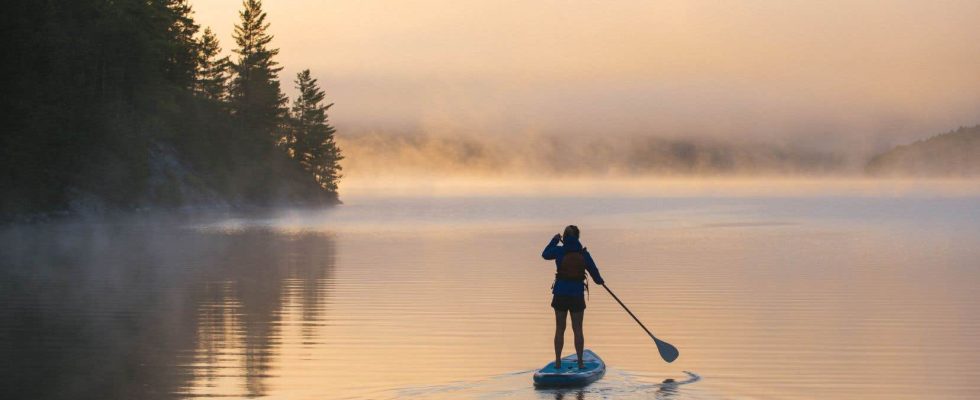This text is part of the special Pleasures notebook
Summer is coming, soon the time to explore one of the most attractive territories in western Quebec. A natural and cultural heritage to be discovered urgently.
On the mirror surface of Lac des Quinze, a small red canoe traces its route towards the shore of the Évasion Témis-Camping campsite, in Fugèreville, the high point of this day rich in action and emotion. On board, the two rowers redouble their efforts to gain a few precious seconds on their timesheet. It was a long day. That same morning, the Raid Témiscamingue competitors learned what their schedule would be like among the mountain biking, trekking, running, kayak and zip line descent. All with a map and a compass, or 170 km covered in 72 hours.
An adventure race
Last year, the second edition of the Raid brought together, in teams of two, 50 enthusiastic participants from Quebec, but also from other Canadian provinces, Latin America and Europe. The competitors were encouraged to surpass themselves and have fun in a supercharged atmosphere in the heart of one of the most dazzling sites in the region. This official event of the Endurance Aventure circuit is above all an opportunity for its organizers to open the doors to a wild territory designed for adventure.
The event takes place in breathtaking landscapes made up of immense bodies of water and inviting islands. Tall red and white pines stand between the deciduous trees, at the junction between the Laurentian forest and the boreal forest.
A documentary about the Raid, filmed last year by a production team, was broadcast in 150 countries. A truly beautiful showcase for a region little known by many Quebecers!
On the Moccasin line
To grasp its excess, head towards Ville-Marie to start on the rock powder cycle path, the Mocassin line. Its 43 km of stunning landscapes unfold on either side of the old railway line.
Fields, forests, plantations, rivers follow one another all the way to Angliers, in the heart of the hinterland. Along the way, you can take a few junctions to increase the number of gourmet stops. As from Laverlochère towards Saint-Bruno-de-Guigues, to give in to the charms of Red Eden, an essential agrotourism stopover in the region where a wide variety of fruits and vegetables are grown. Founded on the farm-to-table concept, the family business also offers, on weekends, a tasty country meal in a relaxed atmosphere.
Want to bite into a pleasantly sweet strawberry? A stop at the Nordvie organic market garden is a must, for a pick-your-own session, but also to pick up all kinds of delicacies produced on site: aperitifs, sparkling juices, slushies and other spices and herbs.
In Lorrainville, we stop at the village cheese factory, where the famous Cru du clocher is made, a raw milk cheddar aged for six months. There is also Cendré de Notre-Dame, a semi-firm paste with a creamy taste.
Outdoors and heritage
Head south, where the Opémican National Park opens one of its four captivating sectors to you. These offer different attractions, depending on whether you want to go hiking, canoeing or expedition kayaking or discover the built heritage of the old timber floating station. The diversity of landscapes and atmospheres promises multiple unforgettable experiences.
Its tall pines which border Lake Témiscamingue give Pointe Opémican a false air of Western Canada. To appreciate its striking beauty, take the Piers trail, which climbs towards panoramic viewpoints, or the Estacade, a 3 km family trail that runs along the lake.
In several areas, Étoile campsites and ready-to-camp campsites invite you to blend into the grandiose landscape and the historical vocation of the territory. It is also explored in Témiscaming, even further south, along the penstock circuit, which traces the old pipes which carried water from the Lumsden dam to the Kipawa hydroelectric power station on Lake Témiscamingue, built to supply a pulp and paper factory in 1919.
Place of memory
Before the construction of the commercial fort in 1720, Obadjiwan Point, in Ville-Marie, was already a gathering place for the Anishinaabe when families met during the summer.
For approximately 200 years, Fort Témiscamingue was the scene of the fur trade run by the Hudson’s Bay Company, the main architect of the trade in skins which supplied Europe. Today, the site co-managed by Parks Canada and the Timiskaming First Nation tells the story and vocation of the place with reproductions of traditional workshops and numerous artifacts in a spectacular environment.
Unmissable on the site of the Obajiwan—Fort-Témiscamingue national historic site: the enchanted forest, an exceptional natural area where you walk under the very old white cedars with their magnificently tortured shapes.
This content was produced by the Special Publications team at Duty, relating to marketing. The writing of the Duty did not take part.
